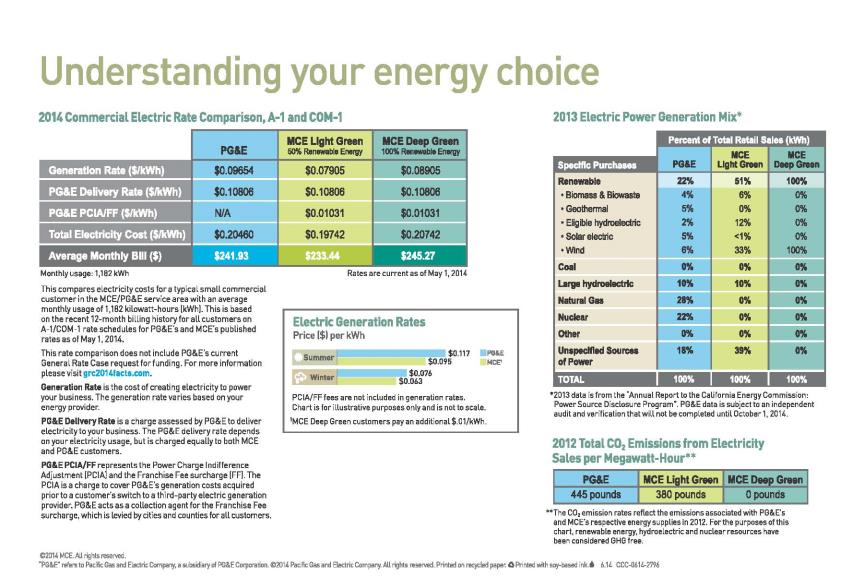| |
Banned by SB 790 from bashing Consumer Choice Aggregation (CCA) without a CPUC approved marketing plan, PG&E is using its primary union partner, IBEW 1245, to lead a legislative attack intended to accomplish what the unpopular and defeated Proposition 16 failed to do – staunch the advance of Consumer Choice Aggregation. (See “Is PG&E Making a Mockery of SB 790?”)
Richmond has benefitted greatly from its membership MEA, the state’s first CCA. Richmond ratepayers enrolled in MCE will save $1.8 million on electricity in 2014 and will have the added benefit of the greenest electricity in California. The City of Richmond will save $60,000 that taxpayers would otherwise have to pay for electricity, and the West Contra Costa Unified School District will save approximately $66,000.
See the Rate Comparison below for details.


CCA’s are gaining traction in California, with Sonoma Clean Power turning the switch on May 1, 2014 and Napa County voting on June 3 to join MEA. Several cities in southern California are in the formative stages of CCA, and the story below describes Alameda County’s efforts to become a CCA.
For more background, see:
AB 2145 has been marketed as a consumer protection and labor bill, but it is neither. In a typical CCA, the investor owned utility (IOU) continues to transmit electric power and bill for it. The generation portion only is provided by the CCA. Even with a CCA, 90% of the labor provided by unions, in PG&E’s case, International Brotherhood of Electrical Workers (IBEW) Local 1245, is for building and maintaining transmission facilities.
Most large renewable generation facilities, including solar, wind and geothermal are also constructed with union labor, including IBEW members. IBEW’s support of AB 2145 is based its relationship with PG&E, not an interest in serving its own interests or those of the public.
The International Brotherhood of Electrical Worker Local 1245, which represents about 12,000 PG&E employees, has a long history of campaigning for the utility’s interests. According to the Marin News, IBEW local 1245’s Business Rep, Hunter Stern, waged a “campaign of misinformation” in support of AB 1245 and against Marin Clean Energy (MCE), the state’s first CCA.
One of his alleged misrepresentations is a statement that that MCE is using electricity that is “dirtier than the power it replaced.
The sponsor of AB 2145, Democrat, Stephen Bradford, is one of the primary recipients of PG&E’s political contributions and a former executive of one of California’s Southern California Edison.
Alameda County: Startup energy agency could power East Bay cities
By Matt O'Brien
" mattobrien@bayareanewsgroup.com
Posted: 06/06/2014 06:52:57 PM PDT0 Comments
Updated: 06/06/2014 08:24:18 PM PDT
OAKLAND -- Move over, PG&E, or at least prepare to share the power lines.
Alameda County is pursuing a plan to become its own energy purveyor for county residents. A new public agency would set its own customer billing rates, buy and sell its own electricity and procure its own clean power from rooftop solar panels and wind turbines along the Altamont Pass.
The startup agency envisioned by environmentalists would not be the first in California, but it could be the biggest in scope and population served. That is, if state lawmakers don't pass a bill this summer imperiling the Bay Area's "community choice" energy movement before it can turn on the switch.
The Alameda County Board of Supervisors unanimously voted Tuesday to take the first step in so-called Community Choice Aggregation, launching a $1.3 million feasibility study that could end with the formation of a new joint powers authority.
Pacific Gas and Electric Co., the giant investor-owned utility, could lose much of its hold over the region if the plan takes shape. PG&E would still distribute electricity and maintain transmission lines on its East Bay grid, and keep reading meters and sending the bills, but the role of choosing and buying energy for most Alameda County customers would shift to the public agency.
"If you have a CCA program, run by a local agency, that local agency doesn't need to pay high-powered CEOs, it doesn't need to maximize shareholder profits at the end of the year," said Bruce Jensen, the county planner helping to craft the new model.
That means rates that are competitive with PG&E, possibly lower, Jensen said. It also means the county of more than 1.5 million people can invest in cleaner, locally produced energy and the jobs that come with it. Residents would have the choice of opting out of the CCA and sticking with PG&E. The boundaries of the agency would depend on which cities wanted to join.
Proponents are pushing the county to be ambitious in developing its own clean energy sources, from its sun-drenched urban and suburban rooftops to wind farms on the Diablo Range.
Alameda County's resources "are much more varied and much more plentiful" than other places that have tried, said Oakland activist Al Weinrub, coordinator of the Local Clean Energy Alliance. "That means there's a lot that could be developed."
Marin County pioneered the concept in 2010, and its Marin Clean Energy authority expanded across the bay to include Richmond in 2012.
Rates are now lower than PG&E, and more than half the energy comes from renewable sources. Environmentally conscious residents can pay a few dollars extra each month if they want to run their homes on 100 percent renewable sources, and those who plug their solar panels into the grid get more money back than they do from PG&E's program.
The pioneer program is working "brilliantly" in Marin after surviving a "very protracted misinformation campaign discouraging potential customers from joining," said Corte Madera resident Leslie Alden, an aide to the late supervisor who spearheaded the program.
"We battled," Alden said. "The motivation for us was climate change and reducing our greenhouse gas emissions. We were thrilled to do it arm in arm with PG&E, but they said no."
A similar agency launched in Sonoma County this spring. Advocates in Santa Cruz, San Benito and Monterey counties are in the early stages of creating their own Monterey Bay program, and San Diego has explored the idea. San Francisco was on the brink of launching its own, but its attempts to wrest power from PG&E in the utility's historic home were log-jammed by politics.
PG&E so far is taking a cordial approach to Alameda County's plan, in part because of a California law that in 2012 banned utilities from using ratepayer funds to fight community power efforts. More actively questioning the project are PG&E union crews represented by the International Brotherhood of Electrical Workers Local 1245. The union rejects the Marin model, arguing that it has not created any union jobs and is not as green as proponents make it out to be. The agency buys most of its renewable energy through credits on the market.
PG&E already provides "some of the nation's cleanest electric power," said utility spokeswoman Tamar Sarkissian.
About 20 percent of PG&E's portfolio now consists of renewable sources, according to the California Public Utilities Commission, and the company is heading toward the state's 33 percent benchmark by 2020. Adding its nuclear and hydroelectric sources, PG&E describes more than half its portfolio as carbon-free.
"At the same time, we respect the energy choices that are available to our customers," Sarkissian said. "We'll continue to cooperate with local governments as they consider pursuing and developing a CCA program."
However, a bill moving through the state Legislature could endanger Alameda County's plan and other local initiatives by forcing customers to "opt-in" once a new Community Choice Aggregation agency takes effect, rather than automatically enrolling them before allowing them to opt out. The bill passed the Assembly in late May with support from local Democrats including Assembly members Bill Quirk, D-Hayward, Rob Bonta, D-Alameda, and Joan Buchanan, D- Alamo, none of whom were available for comment Friday. Assemblywoman Nancy Skinner, D-Berkeley, was the only lawmaker representing Alameda County who voted against it. The state Senate is expected to vote on the bill this summer.
|
|

